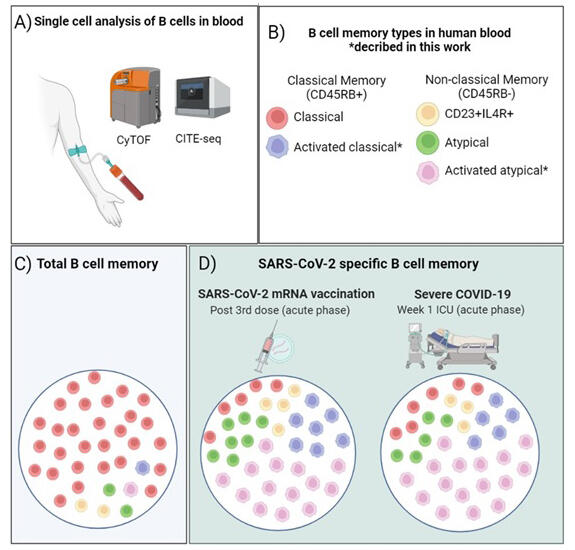Antibodies are produced by B cells due to infection by severe acute respiratory syndrome coronavirus 2 (SARS-CoV-2) or vaccination against it. This antibody production is an important part of the immune response for protection from coronavirus disease 2019 (COVID-19). There are two main groups of human memory B cells: classical and atypical memory cells. Determining whether any given B cell has classical or non-classical origin will be useful in identifying the source and better clarifying the targets of future vaccines. However, once the B cells were stimulated and activated, it was difficult to distinguish between the two. Therefore, whether the activated B cells in vaccinated humans were derived from classical or atypical branches of memory cells remained unknown.
A research group led by Associate Professor James Wing of the Center for Infectious Disease Education and Research at Osaka University and Advanced Postdoctoral Researcher David Priest of the World Premier International Research Center Initiative Immunology Frontier Research Center at Osaka University developed a new method to classify activated B cells by using mass cytometry to evaluate immune responses after mRNA vaccination against COVID-19 or SARS-CoV-2 infection. Using the developed method, they analyzed immune cells at a high order at the single-cell level and found that a new type of B cells, activated atypical B cells, are mainly responsible for the immune responses after both vaccination and infection. The results were published in Nature Communications.

B) Several new types of B-cells were discovered, notable division of activated B-cells into classical and atypical subgroups.
C) Classical memory is the most common type of B cell in healthy donors.
D) Activated atypical B-cells are the most common form of SARS-CoV-2 specific B cell in the blood following mRNA vaccination or COVID-19.
Provided by Osaka University
Using a new mass cytometry method combined with analysis of 150 immune markers, the research group performed a more detailed single-cell analysis of immune cells, which was previously impossible, and successfully characterized the immune cells after vaccination and infection in detail.
As a result, they could classify activated B cells into several groups, among which they discovered activated atypical B cells. These B cells, representing a previously unseen type, accounted for most SARS-CoV-2-specific B cells in human blood and correlated with anti-SARS-CoV-2 antibody levels in serum. Furthermore, CD4 helper T cells, known to enhance atypical B cell responses, were found to proliferate more strongly than follicular helper T cells, which are known to enhance classical B cell responses.
These results indicate that atypical B cells and CD4 helper T cells play a major role in producing anti-SARS-CoV-2 antibodies after vaccination and infection. This improved method for identifying B cell populations in human blood is expected to contribute to the identification of more accurate biomarkers of vaccine response and the development of new vaccines that specifically target these cells.
Wing said, "mRNA vaccines are new, so we don't yet fully know which types of cells respond to mRNA vaccines. Our previous studies showed that several types of memory B cells could be activated, but we did not know which type the activated B cells were. As we found that the primary responders to an mRNA vaccine were activated atypical B cells in this study, we better understand how to target them when designing future vaccines."
Journal Information
Publication: Nature Communications
Title: Atypical and non-classical CD45RBlo memory B cells are the majority of circulating SARS-CoV-2 specific B cells following mRNA vaccination or COVID-19
DOI: 10.1038/s41467-024-50997-4
This article has been translated by JST with permission from The Science News Ltd. (https://sci-news.co.jp/). Unauthorized reproduction of the article and photographs is prohibited.




